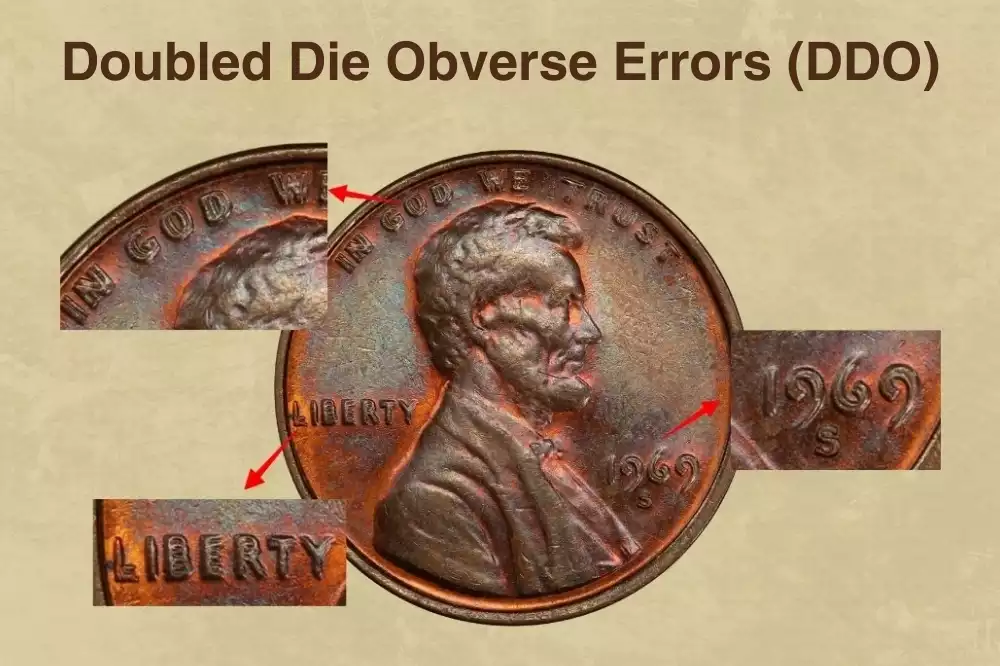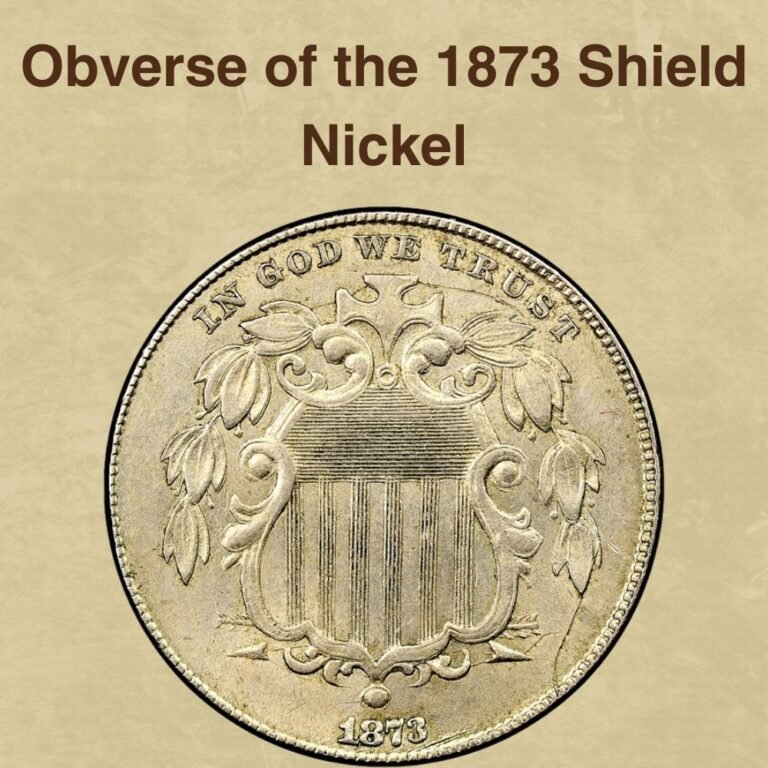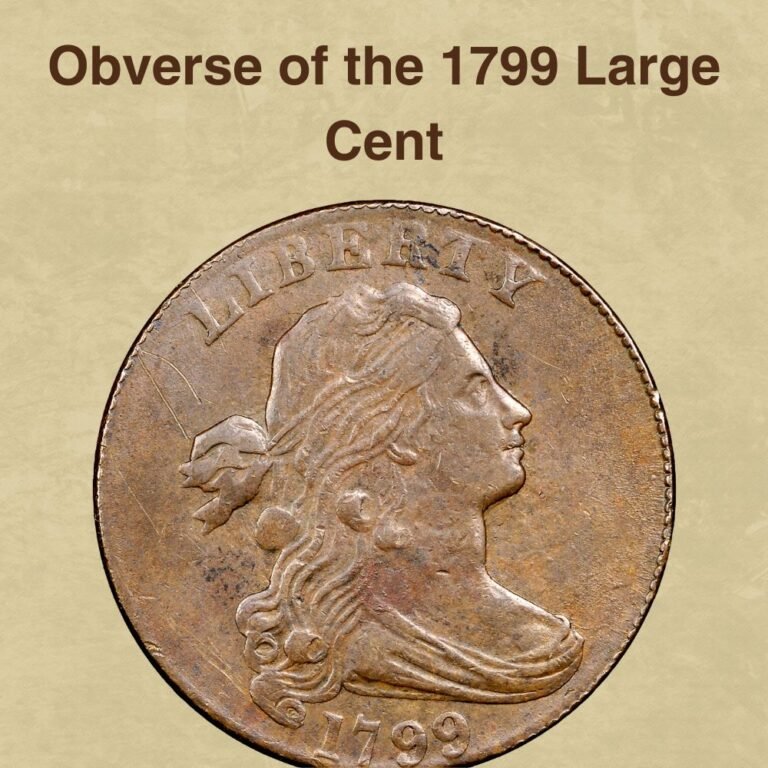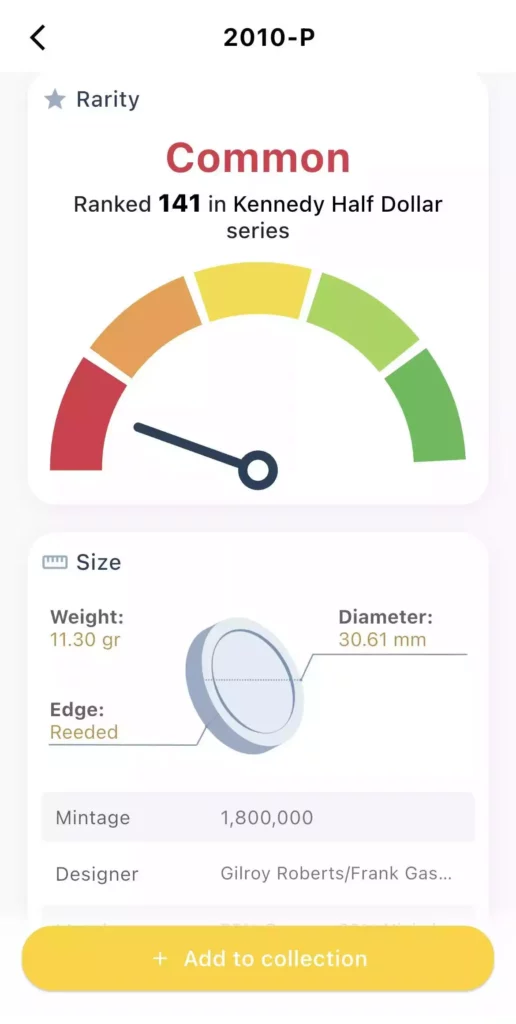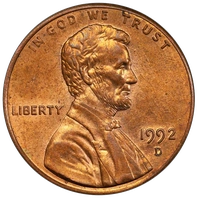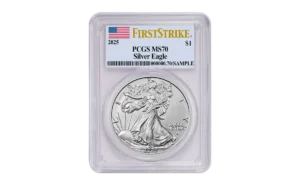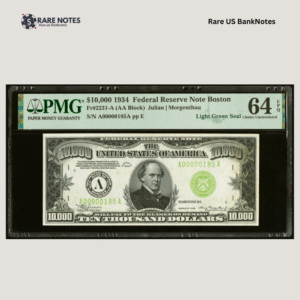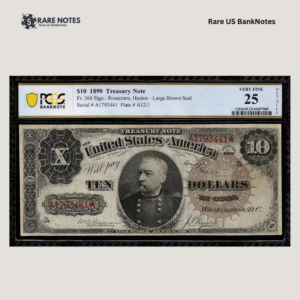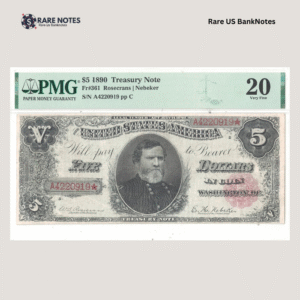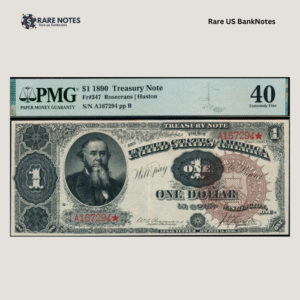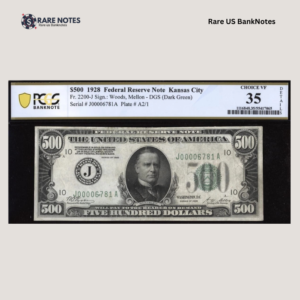Lincoln pennies are among the most fascinating coins in American numismatics, and penny errors make them even more exciting! Whether you’re searching through pocket change or examining inherited collections, this penny error list will help you discover valuable varieties worth hundreds or even thousands of dollars.
From doubled dies to striking mishaps, these penny errors reveal unique stories of mechanical failures and human oversight during the minting process.
Our comprehensive error pennies list with pictures makes it easy to identify these collectible anomalies—transforming everyday coin hunting into an educational and potentially profitable adventure. Each error represents a one-of-a-kind piece of minting history that might be hiding in your change jar right now!
Error Penny List By Year
Pre-1909 Pennies Error (Large Cents & Indian Head Cents)
Year |
Error Types |
|---|---|
| 1793 | AMERI Error, Strawberry Leaf Error |
| 1794 | Fraction Error (No Fraction Bar) |
| 1798 | Partial Overdate (1798/7) |
| 1800 | Partial Overdate (1800/1798) |
| 1807 | Complete Overdate (1807/6), Comet Error |
| 1810 | Partial Overdate (1810/09) |
| 1811 | Partial Overdate (1811/10) |
| 1823 | Complete Overdate (1823/2) |
| 1855 | Knob on Ear Error |
| 1859 | Repunched Date (RPD) |
| 1863 | Misplaced Date (MPD) |
| 1864 | Repunched Date (RPD) |
| 1865 | Repunched Date (RPD), Misplaced Date (MPD) |
| 1867 | Repunched Date (RPD), Complete Overdate (1867/67) |
| 1868 | Repunched Date (RPD), Misplaced Date (MPD) |
| 1869 | Repunched Date (RPD), Complete Overdate (1869/69) |
| 1870 | Misplaced Date (MPD) |
| 1873 | Repunched Date (RPD) |
| 1875 | Repunched Date (RPD) |
| 1882 | Misplaced Date (MPD) |
| 1888 | Repunched Date (RPD), Misplaced Date (MPD), Complete Overdate (1888/7) |
| 1894 | Repunched Date (RPD), Complete Overdate (1894/1894) |
| 1899 | Repunched Date (RPD) |
| 1903 | Repunched Date (RPD), Misplaced Date (MPD) |
| 1904 | Repunched Date (RPD) |
| 1906 | Repunched Date (RPD), Misplaced Date (MPD) |
| 1907 | Repunched Date (RPD), Misplaced Date (MPD) |
| 1908 | Repunched Date (RPD), Misplaced Date (MPD) |
1909-1958 Wheat Penny Errors
Year |
Error Types |
|---|---|
| 1909 | Repunched Mint Mark (RPM) |
| 1910 | Die Breaks/Cracks |
| 1911 | Broadstruck, Die Clash |
| 1916 | Broadstruck |
| 1917 | Doubled Die Obverse (DDO) |
| 1918 | Multiple Strike, Die Breaks/Cracks |
| 1919 | Die Clash, Lamination |
| 1920 | Broadstruck, Clipped Planchet, Lamination |
| 1922 | Weak “D” Error, Missing Mint Mark (No-D) |
| 1925 | Die Clash |
| 1928 | Doubled Die Reverse (DDR) |
| 1929 | Repunched Mint Mark (RPM), Multiple Strike |
| 1930 | Repunched Mint Mark (RPM) |
| 1935 | Multiple Strike, Die Breaks/Cracks |
| 1936 | Doubled Die Obverse (DDO), Broadstruck |
| 1941 | Lamination |
| 1943 | Off-Center Strike, Die Clash, Standard Strike-Through, Clipped Planchet |
| 1944 | Off-Center Strike, Clipped Planchet, Lamination |
| 1945 | Multiple Strike, Lamination |
| 1946 | Broadstruck, Standard Strike-Through |
| 1947 | Repunched Mint Mark (RPM) |
| 1948 | Repunched Mint Mark (RPM) |
| 1950 | Doubled Die Reverse (DDR), Clipped Planchet |
| 1951 | Broadstruck, Die Breaks/Cracks, Die Clash, Standard Strike-Through |
| 1952 | Die Breaks/Cracks |
| 1953 | Die Clash, Standard Strike-Through |
| 1955 | Doubled Die Obverse (DDO), Die Breaks/Cracks, Lamination |
| 1956 | Doubled Die Obverse (DDO), Doubled Die Reverse (DDR), Repunched Mint Mark (RPM), Weak “D” Error, Clipped Planchet |
| 1957 | Die Breaks/Cracks |
| 1958 | Doubled Die Obverse (DDO), Multiple Strike, Off-Center Strike, Die Breaks/Cracks, Die Clash, Clipped Planchet, Lamination |
1959-Present Lincoln Penny Errors
Year |
Error Types |
|---|---|
| 1959 | Doubled Die Obverse (DDO), Doubled Die Reverse (DDR), Split Planchet, Defective Planchet, Standard Strike-Through, Retained Strike-Through, Die Cap, Double Denomination |
| 1960 | Repunched Mint Mark (RPM), Split Planchet, Die Breaks/Cracks, BIE Error, Die Chips |
| 1962 | Double Strikes, Uniface Strikes |
| 1964 | Repunched Mint Mark (RPM), Wrong Planchet, Split Planchet, Defective Planchet, Double Strikes, Die Chips |
| 1965 | Broadstruck |
| 1968 | Off-Center Strike |
| 1969 | Doubled Die Obverse (DDO), Wrong Planchet, No FG Error |
| 1970 | Doubled Die Obverse (DDO), Repunched Mint Mark (RPM), Off-Center Strike, Brockage, Retained Strike-Through, Rotated Die, No FG Error |
| 1971 | Repunched Mint Mark (RPM), Uniface Strikes, Die Cuds, Retained Strike-Through, No FG Error |
| 1972 | Doubled Die Obverse (DDO), Repunched Mint Mark (RPM), Double Strikes, Standard Strike-Through, Die Cap, No FG Error |
| 1973 | Wrong Planchet |
| 1974 | Repunched Mint Mark (RPM), Over Mint Mark (OMM – D/S), Double Strikes, Die Breaks/Cracks |
| 1975 | Off-Center Strike, Die Breaks/Cracks |
| 1977 | No FG Error |
| 1978 | Off-Center Strike |
| 1979 | Off-Center Strike, Die Breaks/Cracks, Rotated Die |
| 1980 | Repunched Mint Mark (RPM), Wrong Planchet, Die Cuds, Die Chips, Fold-Over |
| 1981 | Off-Center Strike |
| 1982 | Double Strikes, Defective Planchet, Unplated/Incomplete Plating, Die Breaks/Cracks, Double Denomination |
| 1983 | Doubled Die Obverse (DDO), Doubled Die Reverse (DDR), Unplated/Incomplete Plating, Die Cuds |
| 1984 | Doubled Die Obverse (DDO), Uniface Strikes, Die Clash, Doubled Ear Error |
| 1986 | Broadstruck, Brockage |
| 1988 | Doubled Ear Error, Flared “G” Error |
| 1990 | Die Chips, Standard Strike-Through, Missing Mint Mark (No-S) |
| 1991 | Brockage, Die Clash |
| 1992 | Doubled Die Reverse (DDR), Close AM Error (1992 & 1992-D) |
| 1994 | Doubled Die Reverse (DDR) |
| 1995 | Doubled Die Obverse (DDO), Unplated/Incomplete Plating, Off-Center Strike, Broadstruck, Die Breaks/Cracks, Fold-Over |
| 1996 | Unplated/Incomplete Plating, Standard Strike-Through |
| 1997 | Unplated/Incomplete Plating, Doubled Ear Error |
| 1998 | Unplated/Incomplete Plating, Brockage, Wide AM Error (business strike), Close AM Error (1998-S proof) |
| 1999 | Unplated/Incomplete Plating, Broadstruck, Die Chips, Die Cap, Double Denomination, Wide AM Error (business strike), Close AM Error (1999-S proof) |
| 2000 | Unplated/Incomplete Plating, Off-Center Strike, Brockage, Wide AM Error (business strike) |
| 2003 | Broadstruck |
| 2005 | Doubled Die Reverse (DDR), Defective Planchet |
| 2007 | Die Chips |
| 2009 | Die Chips |
| 2012 | Die Clash, Standard Strike-Through |
| 2019 | Doubled Die Reverse (DDR) |
| 2021 | Doubled Die Reverse (DDR) |
| 2022 | Doubled Die Reverse (DDR), Die Cuds |
| 2023 | Die Breaks/Cracks, Die Cuds |
| 2025 | Doubled Die Reverse (DDR), Die Breaks/Cracks, Die Cuds, Die Chips |
error pennies list with pictures
1. Doubled Die Obverse (DDO) Errors

Doubled die obverse errors occur during the die-making process when the working hub impresses the design onto the working die more than once in slightly different positions. This creates doubled images of letters, numbers, or design elements on the coin’s obverse side.
In Lincoln pennies, DDO manifestations typically appear in specific obverse elements. The most common locations include doubling in the date, “IN GOD WE TRUST,” “LIBERTY,” and Lincoln’s profile features.
Strong doubling is seen on the tops of the letters of the motto IN GOD WE TRUST, suggesting that a complete obverse design was hubbed over an incomplete design, with misalignment between the two images.
Notable examples include the famous 1969-S DDO and 1972 DDO varieties, along with discoveries like the 1995 doubled die Lincoln cent that surfaced as the first new major doubled die Lincoln cent in more than a decade.
Values vary dramatically, with premium examples like the 1969-S commanding thousands of dollars, while a minor but exceedingly rare 1972 Doubled Die Obverse Lincoln cent graded PCGS MS-66 RD sold for $21,811. Less dramatic DDO varieties from other years typically command modest to moderate premiums among variety collectors.
Known DDO Error Years for Lincoln Penny:
2. Doubled Die Reverse (DDR) Errors

Doubled die reverse errors form during the die-making process when the working hub creates multiple impressions on the working die at slightly different positions or angles. The formation process involves mechanical misalignment during the hubbing process, where the hub that creates the reverse design is impressed more than once onto the die face.
In Lincoln pennies, DDR errors manifest differently across the two main reverse designs.
With DDR errors, in the wheat Reverse period (1909-1958), the doubling appears on the reverse side elements such as the wheat stalks, inscriptions like “ONE CENT” and “UNITED STATES OF AMERICA”. During the Memorial period (1959-2008), doubling typically appears on the Lincoln Memorial columns, steps, or inscriptions like “ONE CENT” and “UNITED STATES OF AMERICA.” In the Shield period (2010-present), DDR errors show doubling in the shield’s vertical stripes, horizontal bands, or surrounding text elements.
DDR errors are generally less valuable than their DDO counterparts because the reverse design changes are often subtler and less noticeable to casual observers. Values typically range from $50-$5,000 depending on the year, severity of doubling, and coin grade. The 1983 DDR is among the most valuable, with high-grade examples reaching several thousand dollars.
Known DDR Error Years for Lincoln Penny:
3. Repunched Mint Mark (RPM) Errors

When the Mint started using mint marks in the early 1800’s to identify the various branch mints, the mint mark was hand punched into the working dies. A die maker would take a thin steel rod (punch) that had the mint mark engraved on it and manually hammer it into each working die.
The human element created inevitable errors. If the initial punch wasn’t properly positioned or deep enough, die makers would re-punch the mint mark, often slightly offset from the original. This created the distinctive “shadow” effect we call a “repunched mint mark (RPM) error,” where you can see multiple impressions of the same letter—like D/D or S/S varieties.
Notable examples of pennies include the 1959 D/D/D RPM FS-501, which features three different “D”s. A 1959 D/D/D RPM MS66 RD sells for over $800. The 1968-D/D and 1987-D/D are also well-documented RPMs that collectors actively seek. Values of these RPM error coins typically range from $15-$500.
What makes RPMs particularly interesting is their historical significance—they represent the last era of hand-crafted coin production before automation eliminated such errors. By the 1990s, computerized processes largely eliminated RPMs, making earlier varieties increasingly appreciated as artifacts of traditional craftsmanship.
Known RPM Error Years for Lincoln Penny:
4. Repunched Date (RPD) Errors
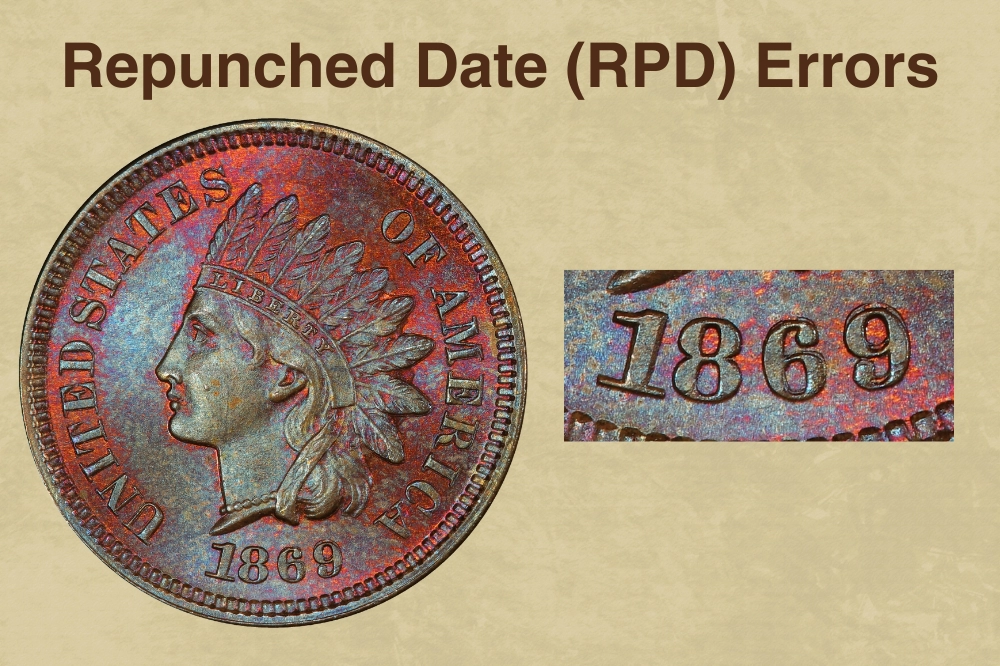
Repunched Date errors flourished in Indian Head and early Lincoln cents due to manual die preparation methods.
Before 1909, mint workers hand-punched dates into softened dies using steel punches and hammers. When initial strikes misaligned or lacked depth, workers repunched at slightly different angles, creating visible doubling or “shadow” digits beneath primary numbers. Some varieties exhibit dramatic triple punching.
Indian cents feature numerous RPD varieties, making them a staple of that series’ die variety collecting. The 1869/69 Indian cent offers three RPD varieties (FS-301, FS-302, FS-303), with values averaging $130 in good condition and reaching $960 in almost uncirculated grades.
Most RPDs command modest premiums, typically ranging from a few dollars in worn condition to several hundred for exceptional mint state examples, though values vary significantly based on the variety’s prominence and the coin’s overall grade and preservation.
However, strong RPD examples with exceptional preservation remain sought-after by dedicated variety collectors who prize these hand-crafted imperfections from numismatics’ pre-automation era.
Known RPD Error Years for Penny:
- 1859
- 1864
- 1865
- 1867
- 1868
- 1869
- 1873
- 1875
- 1888
- 1894
- 1899
- 1903
- 1904
- 1906
- 1907
- 1908
5. Misplaced Date (MPD) Errors
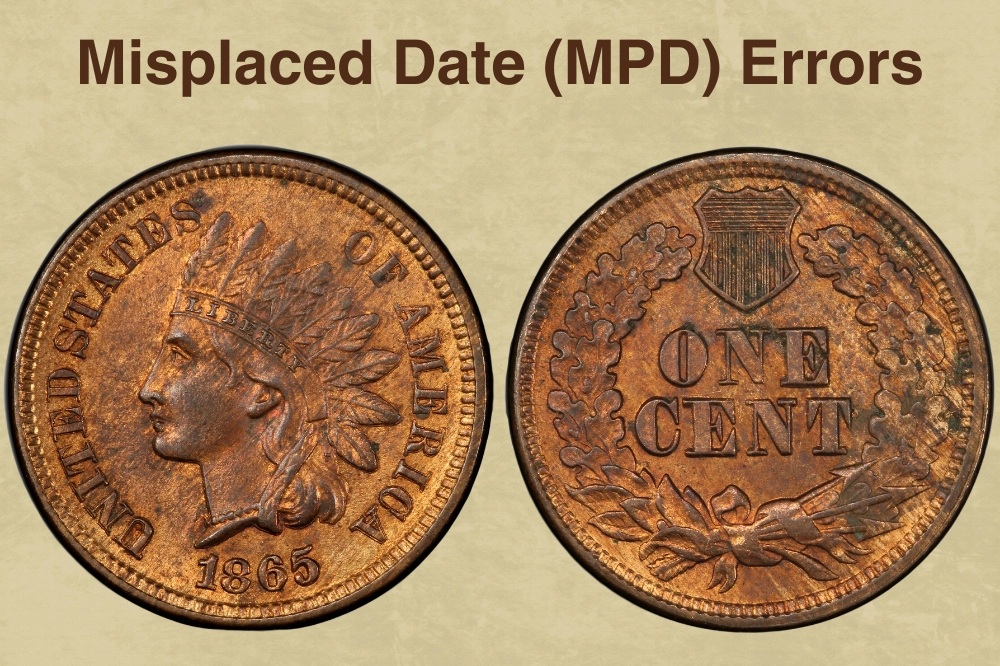
Misplaced Date errors present an intriguing glimpse into pre-1909 manual die preparation. These varieties display date digits appearing in unexpected locations—commonly lurking within denticles, protruding from busts, or embedded in design elements far removed from the intended date position.
Various theories explain MPD formation, including testing die hardness with preliminary taps, accidentally resting number punches with excessive force on annealed dies, malpositioning of logo-punch apparatus, or simple positioning errors. Workers typically punched in areas they believed striking would obscure, though this didn’t always work as planned.
The confined workspace complicated matters—Indian cents offered merely one-eighth inch height for date placement between bust and denticles. A tenth-inch misalignment easily punched digits into wrong areas, and workers often didn’t bother correcting microscopic errors invisible to naked eyes.
This practice ended in 1909 when dates were incorporated into master dies rather than hand-punched into individual working dies.
Market values reflect visibility and rarity. The 1906 Indian Head cent with digits in denticles sold for $599 in higher grades, while EF45 examples typically command $30. An 1854 Large Cent showing partial four below the bust achieved $300 in MS64 condition.
MPDs appear across sixteen Indian Head cent issues, making them relatively accessible to variety collectors who appreciate these unintentional testimonies to nineteenth-century hand craftsmanship.
Known MPD Error Years for Penny:
- 1863
- 1865
- 1868
- 1870
- 1882
- 1888
- 1903
- 1906
- 1907
- 1908
6. Complete Overdates Errors
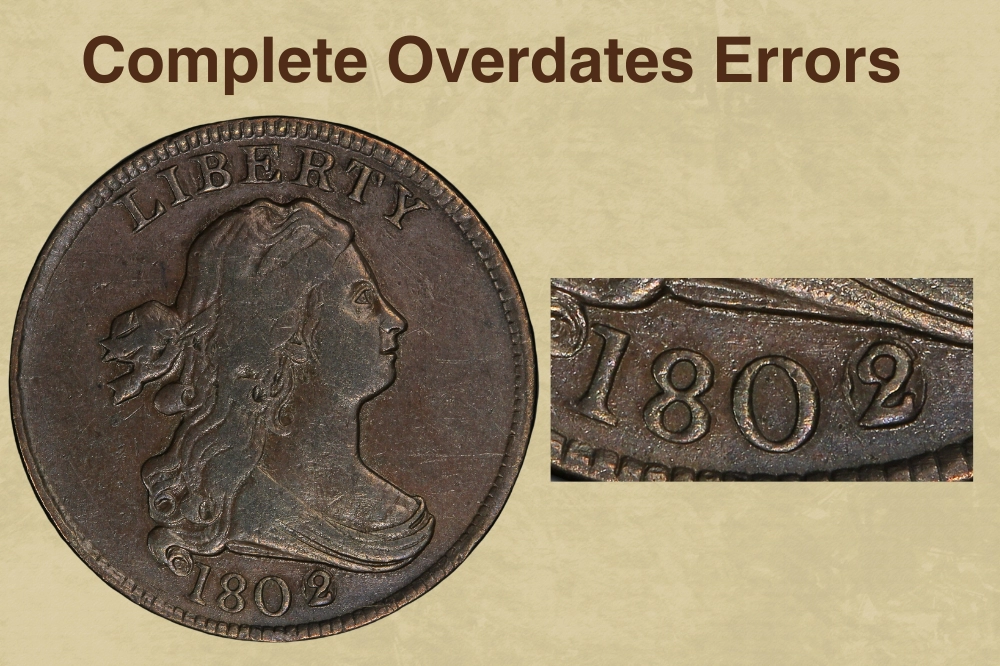
Complete overdates occurs when mint workers punched fresh date numerals directly over an existing dated die without thoroughly removing or grinding down the previous year’s digits.
The defining characteristic lies in the clear discernibility of both date layers, with the earlier year’s numbers leaving prominent traces that collectors can easily spot without magnification. The 1802/0 half cent exemplifies this type magnificently, with the underlying zero’s circular form completely encircling the punched-in two.
Market values for complete overdates vary tremendously based on scarcity and preservation quality. The exceptionally rare 1802/0 with Reverse of 1800 commands approximately $38,000 in average condition, with fewer than twenty known specimens, while the more common 1802/0 with Reverse of 1802 typically brings around $2,700.
Similarly dramatic examples like the 1918/7-D Buffalo Nickel have reached $250,000 at auction in top grades, demonstrating how collectors prize the dramatic visibility of dual dates and their tangible connection to early minting practices.
Known Complete Overdate Error Years:
- 1807/6
- 1823/2
- 1867/67
- 1869/69
- 1888/7
- 1894/1894
7. Partial Overdate Errors
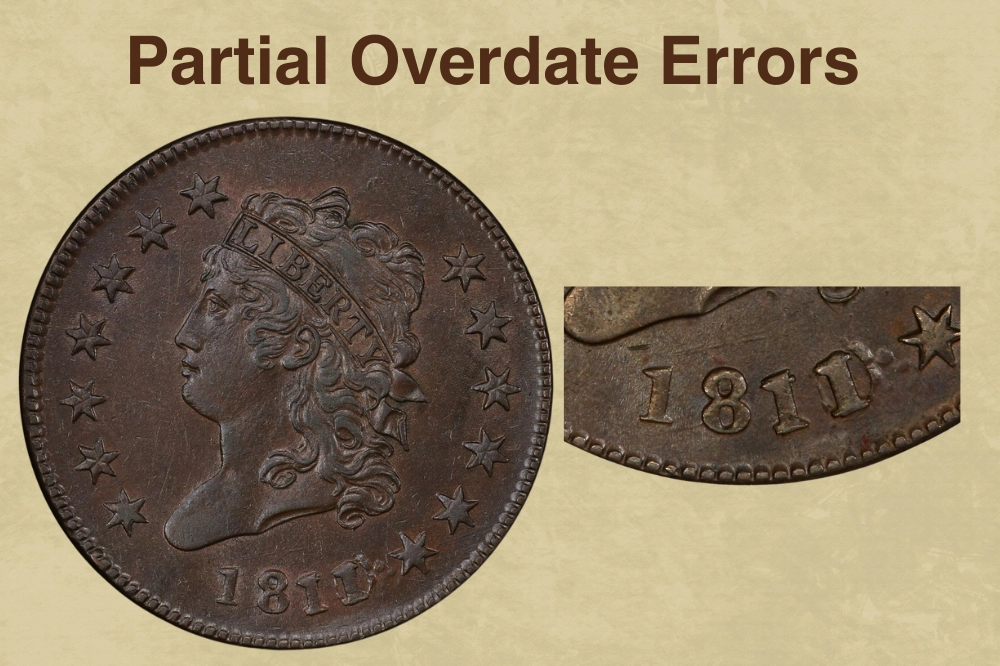
Partial overdates present a more subtle challenge for collectors, displaying only fragmentary remnants of the earlier date beneath the newer numerals. These varieties emerged when mint engravers attempted to file down or abrade portions of the old date before repunching the current year, though the hardness of die steel made complete erasure nearly impossible with period tooling.
The distinguishing feature involves faint traces of previous digits, often requiring careful examination under magnification and proper lighting angles to detect. Only specific portions might remain visible, such as curved segments from a zero or the tail end of another numeral peeking out from beneath the newer punch.
The 1811/0 large cent demonstrates this type effectively, where just subtle vestiges of the underlying zero appear beneath the final one. Market valuations for partial overdates typically reflect their more understated appearance compared to complete overdates.
The 1811/0 large cent averages around $700 in circulated grades, approximately three times scarcer than the normal 1811 date, though still considerably more affordable than dramatic complete overdates.
Specimens where traces barely register command lower premiums than those displaying clearer evidence, as authentication difficulty increases when remnants fade toward imperceptibility. Collectors particularly value examples where the partial characteristics remain distinct enough to confirm the variety confidently without extensive magnification.
Known Partial Overdate Error Years:
- 1798/7
- 1800/1798
- 1810/09
- 1811/10
8. Over Mint Mark (OMM) errors

An Over Mint Mark (OMM) is a distinct numismatic variety where two different, overlapping mintmarks are present. The obscured mintmark (the one that is punched in first) is usually thinner and smaller than the definitive mintmark. This technical distinction separates OMMs from Repunched Mint Marks (RPMs), where the same mint mark appears multiple times.
The formation process involves deliberate die modification during production. This may be due to having been weakly punched into the working die or it may reflect an attempt to abrade (remove) the first mintmark before punching in the second mintmark.
The most documented examples are the 1974-D/S Lincoln cents, it demonstrate wartime production pragmatism—San Francisco dies were reassigned to Denver Mint operations due to die shortages. The original “S” mint mark was partially ground away before the “D” was punched over it, but remnants of the underlying “S” remain visible under magnification.
OMMs are significantly rarer than RPMs due to their specific formation requirements involving two different mint facilities. Values range from $200-$2,000+ depending on the visibility of the underlying mint mark and coin grade, making them highly sought after by advanced collectors specializing in mint mark varieties.
Known OMM Error Years for Lincoln Penny:
9. Wrong Planchet Errors (penny on dime planchet, nickel planchet, etc.)

Wrong planchet errors, also called off-metal strikes, occur when Lincoln cents are accidentally struck on planchets intended for other denominations. A planchet is the blank disk of metal, featureless except for a slightly raised proto-rim on both sides, used to strike a coin. These dramatic errors result from production line mix-ups where different denomination planchets become commingled in the striking chambers.
The most common wrong planchet varieties include pennies struck on dime planchets (creating silver-colored cents), nickel planchets (producing larger, heavier cents), and occasionally foreign planchets. A 1959-D Lincoln cent… was struck on a silver planchet intended for a Roosevelt dime, demonstrating how these errors occur when planchet bins are accidentally mixed or cross-contaminated during the production process.
Values vary significantly based on the host planchet’s composition and rarity. Pre-1965 silver dime planchets command premium prices due to their silver content and historical significance. The rare 1973 Lincoln Penny struck on a dime planchet has been valued at $26,400, while typical wrong planchet errors range from $500-$5,000+ depending on grade and scarcity.
These errors are immediately recognizable due to their distinctive weight, size, and often color differences, making them among the most visually dramatic mint errors that even novice collectors can easily identify.
Known Wrong Planchet Error Years for Lincoln Penny:
10. Unplated/Incomplete Plating Errors
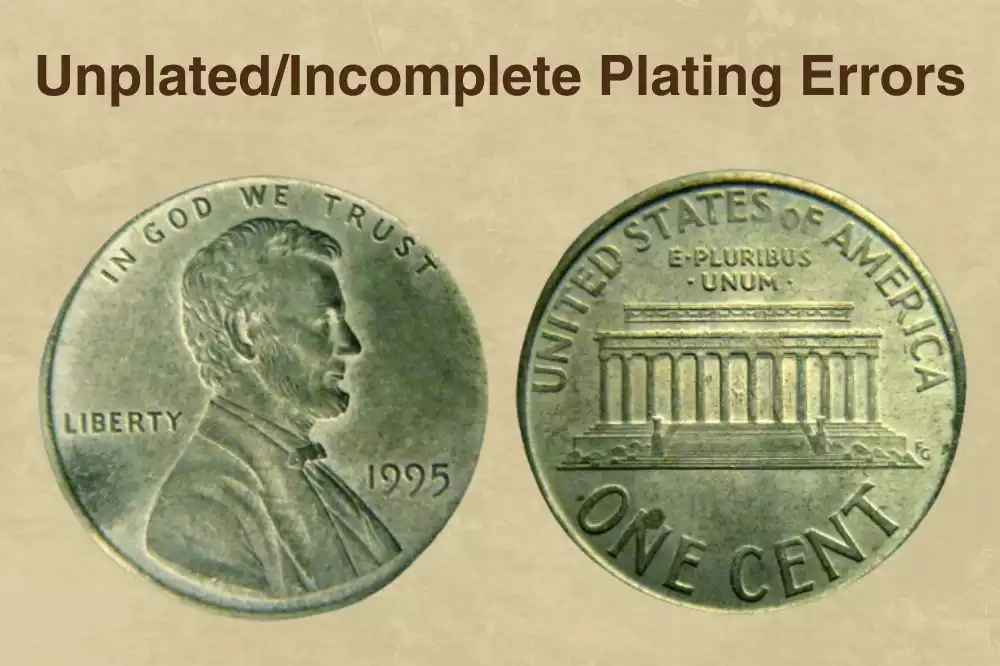
Unplated and incomplete plating errors represent a significant category of Lincoln cent mint errors that became possible only after 1982, when the U.S. Mint transitioned from solid bronze composition to copper-plated zinc planchets.
These errors occur when zinc planchets either completely miss the copper electroplating process or receive insufficient copper coating, exposing the underlying zinc core. Documented examples include unplated 1984 and 1995 Lincoln cents, with these errors creating distinctive silvery-white appearances due to the exposed zinc surface.
These errors hold historical significance as they directly relate to the 1982 compositional change, representing transitional period minting irregularities.
The value of these error coins depends on their year and condition. Genuine unplated pennies are highly sought after by error coin collectors due to their rarity and visual impact. Counterfeits of these error coins are common, typically created outside the mint by chemically removing the copper plating from ordinary pennies. Therefore, careful authentication is crucial to distinguish genuine mint errors from artificially created specimens.
Known Unplated/Incomplete Plating Error Years for Lincoln Penny:
11. Split Planchet Errors

A split planchet coin error occurs when, during the preparation of the planchet strip, impurities such as gas, dirt, or grease become trapped under the surface of the metal blank, creating a weakness or lamination defect. The contamination creates internal stress points that compromise the metal’s structural integrity.
These defects manifest when this weak area of the metal may flake, peel, or split because the adhesion is poor. The splitting can occur before or after striking, creating dramatic visual effects where portions of the coin appear to separate along horizontal planes.
What makes these errors particularly intriguing is their unpredictability—the same contamination that creates weakness might not manifest until years after striking, when environmental factors trigger the final separation. Split planchet errors are normally restricted to planchets composed of a solid alloy, such as U.S. cents and nickels.
Values depend heavily on the extent and dramatic nature of the split, ranging from $75-$800+. Coins with complete layer separation or unusual splitting patterns command higher premiums among error coin specialists.
Known Split Planchet Error Years for Lincoln Penny:
12. Defective Planchet Errors

A defective planchet is a planchet with any number of problems and these problems occur before the strike and usually happen during the planchet manufacturing process, distinguishing them from striking errors that occur during coin production.
These defects include various metallurgical and physical imperfections: incomplete annealing creating uneven metal hardness, roller marks from improper strip preparation, pitting and surface irregularities from contaminated alloys, and dimensional variations from faulty cutting operations.
Zinc-core Lincoln pennies are particularly susceptible to plating defects, gas bubbles trapped during the electroplating process, and core-to-plating adhesion failures. These manifest as unusual surface textures, weight variations, or visible core exposure before striking.
Values of these coins typically range from $25-$400 depending on the severity and visual impact of the defect. Despite its circulated state, it is still a valuable addition to any collection due to its rarity and unique features, particularly for dramatic examples showing multiple concurrent defects or unusual manufacturing anomalies.
Known Defective Planchet Error Years for Lincoln Penny:
13. Off-Center Strikes Errors (various percentages)

Off-center strikes occur when the planchet is improperly positioned in the coining chamber during the striking process. Off-center coins happen during the striking process when the coin does not align properly in the coining press. This misalignment results in only a portion of the design being impressed on the planchet, creating dramatic visual errors where part of the coin remains blank while design elements are cut off or missing.
All off-center coins are missing some part of the design on at least one side of the coin, which can include the lettering, central design detail, or the dentils on the coin’s rim. The severity is measured by percentage—a 50% off-center strike means half the design is missing, while a 90% off-center coin shows only a small portion of the original design.
Value depends heavily on the percentage of off-centering and whether the date remains visible. The value of off-center strikes depends on the amount off-center and the amount of wear. Based on documented cases, 1968 pennies, 1970-D cents, and 1978 Lincoln pennies have been found with off-center strikes, with values ranging from $75-$500+ depending on the degree of misalignment and overall condition.
Known Off-Center Strikes Error Years for Lincoln Penny:
14. Double Strikes Errors

Double strike errors occur when a coin receives two impressions from the dies during the minting process.
This happens when a coin fails to eject properly from the press after the initial strike and remains in position for a second impact. The second strike can be centered, off-center, or rotated, creating distinctive overlapping images that make the design elements appear doubled or displaced.
Formation typically results from mechanical malfunctions in the coining press ejection system, causing the struck coin to remain in the collar or die area. The severity and type of doubling depends on the coin’s position during the second strike.
These errors have become increasingly rare since 2002 when the U.S. Mint implemented enhanced quality control systems that prevent most major errors from leaving the facility. This scarcity has enhanced their collectible value significantly.
Values vary considerably based on the year, condition, and dramatic nature of the doubling effect, with more pronounced errors commanding higher premiums among specialized error coin collectors. In-collar double strikes typically range from $75-$300, while dramatic off-center double strikes can command $200-$1,000+.
Known Double Strikes Error Years for Lincoln Penny:
15. Multiple Strike Errors
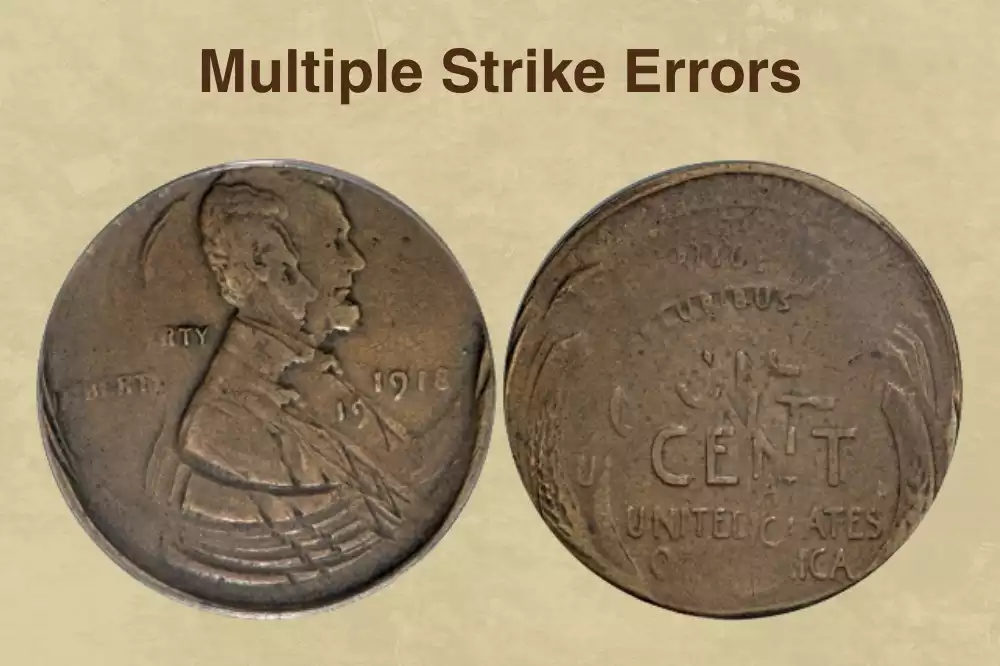
Multiple Strike errors form through a mechanical failure in the coin minting process. This occurs when a coin is struck correctly on the first attempt but fails to be ejected from between the dies due to problems with the coin press’s ejection system. The feeder finger, which places planchets between dies and ejects struck coins, malfunctions and doesn’t properly remove the coin from the die chamber.
When this happens, the coin receives additional images from being struck again, typically off-center, creating what’s sometimes called a “double exposure”. The dies continue to strike the coin a second, third, or more times until either the coin is finally ejected or a mint employee notices the press malfunction and stops the machine.
Sometimes coins move or rotate between strikes, creating clear evidence of multiple impressions with different orientations. The result is a coin bearing overlapping images from successive strikes, making it easily distinguishable from doubled die varieties, which are created during die manufacturing rather than the striking process.
Multiple Strike errors would likely command higher premiums than double strikes due to their dramatic appearance and rarity. Based on general mint error pricing patterns, Multiple Strike wheat pennies could potentially range from $50 to several hundred dollars depending on the number of strikes, condition, and specific year.
Known Multiple Strike Error Years for Penny:
16. Broadstruck Errors

Broadstruck errors occur when a coin is struck without the presence of a retaining collar, the metal ring that normally constrains the planchet during striking.
When the retaining collar fails to function correctly, the metal flows outward unrestricted during the striking process, creating coins that are thinner and wider than normal specimens. These errors must display the complete design to qualify as broadstrikes rather than off-center strikes.
Market values for broadstruck Lincoln cents vary significantly based on year, condition, and dramatic nature of the error. They may be worth $9 to $25, depending on how wide and apparent their error looks. A 1999 broadstruck Lincoln cent graded NGC MS64 RD that sold for $9.52 in June 2019. While this represents a modest value, more examples from scarcer years or higher grades can command substantially higher premiums.
More dramatic examples with significant size increases can command higher premiums as well. Depending on the denomination and the coin’s condition, a significant size broadstrike error coin can be worth anywhere from $5 to $1,000… on up!
These errors remain collectible due to their distinctive appearance and the mechanical failure story they represent, making them attractive to specialized error coin collectors seeking unusual minting anomalies.
Known Broadstruck Error Years for Lincoln Penny:
17. Brockage Errors

Brockage errors create one of the most visually striking mint errors, featuring a mirror image of one side of the design impressed on the other. This occurs when an already minted coin sticks to the die surface instead of falling off. This coin then leaves an impression of its reverse or obverse design on the incoming blank planchet.
The formation process involves a mechanical failure where when a coin sticks to the upper or lower die a number of brockage strikes may occur from the same coin (which at this stage is known as a “die cap”). The first strike from the “capped die” will result in a “mirror brockage” that will exhibit a perfect incuse mirror image of the design. This creates a sunken, reversed impression instead of the normal raised relief.
Mirror brockages in the pennies are extremely rare, making them highly sought after by collectors.
Brockage examples include a 2020 Lincoln cent brockage error and recent discoveries where the obverse features typical Lincoln portrait while the reverse shows mirrored impression with visible backward letters. Values can reach thousands of dollars for clear, dramatic examples, with pricing dependent on the completeness and clarity of the mirror image.
Known Brockage Error Years for Lincoln Penny:
18. Uniface Strikes Errors
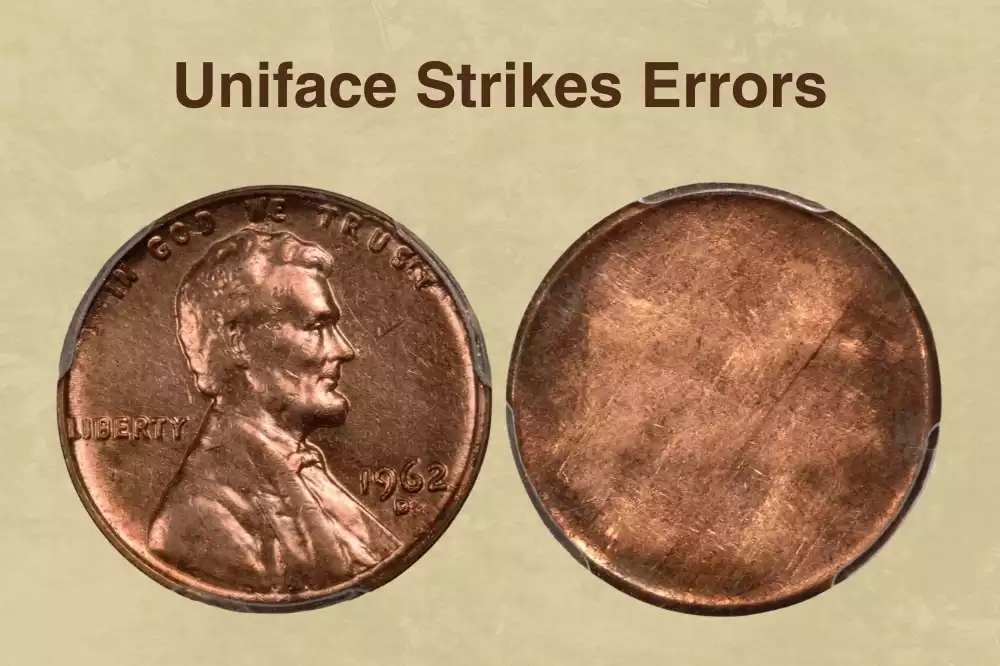
Uniface strikes are dramatic mint errors where a coin displays a complete design on one side while the other side remains completely blank or shows minimal impression.
The formation mechanism involves multiple planchets accidentally stacking in the striking chamber. When the press operates, the upper planchet receives the full impression from one die, while the lower planchet prevents the opposite die from creating its design. The result is a coin with normal relief on one side and a blank, unstruck surface on the other.
These errors are extremely rare because high-speed coining operations have sophisticated feeding mechanisms designed to prevent multiple planchet scenarios. Quality control systems typically catch such dramatic errors before coins reach circulation, making authentic examples highly sought after by collectors.
If the uniface coin is a trial strike, die cap error, or two planchet error, it has strong collector value due to their rarity and visual impact. The 1984 uniface reverse strike penny error represents a documented case in the Lincoln series, which fetch up to $155 or more, depending on the coin’s condition, demonstrating the premium collectors place on these rare striking anomalies.
Known Uniface Strikes Error Years for Lincoln Penny:
19. Die Breaks/Cracks Errors

Die breaks and cracks errors occur when the steel dies used to strike coins develop fractures due to metal fatigue, excessive use, or manufacturing flaws. Hairline cracks may begin showing on aging dies — and these cracks on the die can result in raised lines on the coin. These lines (called die cracks or die breaks) appear as raised metal ridges on the struck coins.
There are several types of die breaks: interior die breaks (appearing within the coin’s design), marginal die breaks or “cuds” (occurring at the rim), and die cracks (linear fractures across the die surface). When metal flows away from areas affected by die breaks, it creates flatness in the strike, which is actually part of the error itself.
Die break varieties have been recorded throughout the pennies, including examples from 1974-S, 1975-D, and 1979 varieties, though specific premium values for individual years vary based on the severity and visual appeal of the particular die break. An example with this striking error may be worth $5 up to $25. Some are worth $100 or more for higher grade examples.
Known Die Breaks/Cracks Error Years for Lincoln Penny:
20. Die Cuds Errors

Die cuds are a specific type of die break error.
A cud is a raised area on the rim of a coin’s surface caused by a die break where a piece of the die is missing. When the broken piece falls out completely, it creates a void that fills with metal during striking, forming a raised, blob-like area on the finished coin.
Lincoln pennies exhibit documented cud errors throughout their production period. Examples include cuds from the 1980s decade and recent discoveries like a 2025-S Lincoln Shield cent with a rim cud break on the reverse.
Some die break error coins are worth $100 or more, depending on their rarity and dramatic appearance. Values depend on the size and location of the cud, with larger, more prominent cuds commanding higher premiums in the error coin market.
Known Die Cuds Error Years for Lincoln Penny:
21. BIE Errors (die break between B and E in LIBERTY)

BIE errors are a specific type of die break exclusive to Lincoln cents that occurs between the letters “B” and “E” in the word “LIBERTY” on the obverse. The die break between the B and E looks something like an I, so it’s called B-I-E or BIE error. This creates the appearance of an extra letter “I” making “LIBERTY” appear as “LIBIERTY.”
The formation results from metal fatigue causing a crack or chip in the die surface between these specific letters. Die chips that cause protrusions or blobs to appear on struck coins were unusually common on U.S. coins of most denominations struck during the 1950s and early 1960s.
BIE errors are among the most collectible Lincoln cent varieties because they’re easily recognizable to novice collectors and occur frequently enough to make collecting feasible.
Values vary based on year, condition, and prominence of the BIE feature, with some examples commanding modest premiums among specialized variety collectors who appreciate these distinctive die break errors.
Known BIE Error Years for Lincoln Penny:
22. Die Chips Errors

Die chips are small pieces of metal that break away from the coin die surface during the striking process, creating distinctive raised metal bumps or irregular protrusions on struck coins. These errors form when the repeated stress of high-pressure coin production causes small fragments of the hardened steel die to fracture and separate from the main die surface.
The formation process involves metal fatigue from thousands of striking cycles. As dies age, micro-cracks develop in areas of high stress concentration. Temperature fluctuations during production can accelerate this deterioration. When a small piece of the die finally breaks away, subsequent coins struck by that die will show a raised metal blob where the missing die piece should have created normal surface detail.
Die chips differ from die breaks or cuds in that they’re typically much smaller and more isolated. They often appear as small raised dots or irregular metal bumps scattered across the coin’s surface, rather than the larger, more dramatic features associated with major die breaks.
Die chip errors generally command modest premiums in the collector market, typically ranging from $10-$35 depending on the size, location, and visual prominence of the chip.
Known Die Chips Error Years for Lincoln Penny:
23. Die Clash Errors

Die clashes are a type of error coin resulting when when the coining press experiences a mechanical malfunction, causing the obverse and reverse dies to come into direct contact. This creates faint impressions of one die’s design transferred onto the opposite die surface.
Die clash errors are categorized as typical die clashes (TDC) and atypical die clashes (ADC). Values are generally modest, typically ranging from a few dollars to moderate premiums depending on the prominence of the clash marks and the specific year, with most examples valued for their technical interest rather than significant monetary worth.
Known Die Clash Error Years for Lincoln Penny:
24. Standard Strike-Through Errors

Standard Strike-Through Errors occur when foreign object comes between the die and the blank when it is being struck. The foreign object becomes impressed into the blank’s surface, and it distorts the finished product.
Formation results from foreign matter plugs the cavity into which the planchet’s metal would normally flow under the striking pressure, causing missing design elements where the object blocked proper contact.
The most common and likely to make its way into circulation is a mistrike known as a strikethrough. These errors display incomplete design elements with smooth or textured areas where foreign objects interfered during striking. The object or substance itself will not be “retained” on the coin, distinguishing standard strike-throughs from retained varieties.
Most struck throughs are extremely small, caused when tiny pieces of dust or other nearly microscopic particles are inadvertently struck into a coin. Identification requires examining areas with missing design details that show clear boundaries and may retain texture impressions from the interfering material.
Market values depend on the size, location, and visual impact of the strike-through area. While specific documentation of penny years with standard strike-through errors is limited, errors can occur in any year, making every Lincoln cent potentially valuable.
Known Standard Strike-Through Error Years for Lincoln Penny:
25. Retained Strike-Through Errors

Retained strike-through errors, also known as embedded struck-through errors, occur when foreign objects become permanently embedded in the coin’s surface during the striking process.
The formation happens when debris such as cloth, grease, paper, wire fragments, or other materials gets trapped between the die and planchet during striking. Unlike standard strike-through errors where the object falls away, retained errors involve the foreign material becoming permanently fused into the coin’s surface under the immense striking pressure.
Lincoln pennies show documented retained strike-through errors across multiple years. Examples include a 1970-D cent with retained strike-through error and a 1959-D Memorial cent.
Values retained strike-through coins depend on the size, location, and nature of the embedded material. Retained strike-through errors typically command higher premiums than standard strike-through errors due to their dramatic appearance and the rarity of having foreign material permanently embedded in the coin.
Known Retained Strike-Through Error Years for Lincoln Penny:
26. Die Cap Errors (obverse/reverse)

Die cap errors occur when a coin sticks to the hammer die and if it remains on the die long enough it will spread around the outside of the die, forming what looks like a bottle cap. As it continues to strike more coins, the cent that is stuck to the die becomes shaped like a bottle cap, hence the name “Capped Die”. These errors progress through stages as the cap remains on the die and strikes additional planchets.
The first planchet struck after formation of the cap will be left with a clear, complete brockage of the obverse design on the reverse face. Subsequent brockages will be increasingly expanded, distorted, and incomplete. Die caps can eventually become worn smooth from repeated striking, creating various effects on coins struck through them.
Identification involves looking for unusual impressions, brockages, or incuse designs that result from coins being struck through the cap. Die cap-related errors have occurred in pennies, with examples found in years like 1999 and 1972.
Their market values vary significantly based on stage and condition. Lincoln cent struck through die cap errors are valued at approximately $300 for uncirculated examples, though prices can fluctuate based on rarity and collector demand for specific error types.
Known Die Cap Error Years for Lincoln Penny:
27. Fold-Over Errors
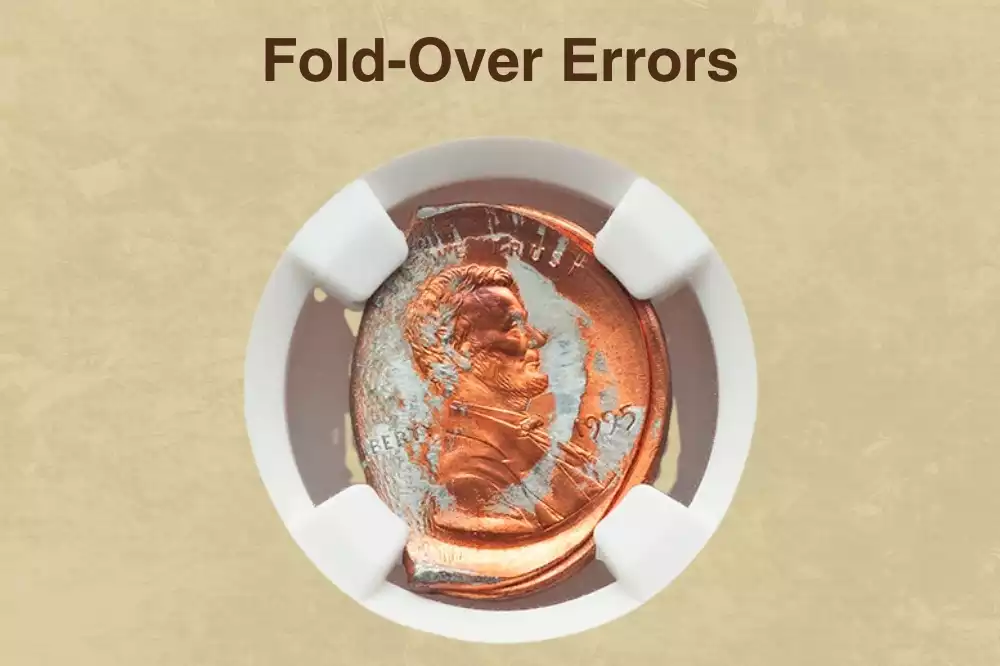
Fold-over errors occur when a portion of the planchet folds onto itself during the striking process, creating a coin where part of the metal is doubled over. The formation happens when the planchet is improperly fed into the coining press or when mechanical issues cause the blank to buckle or fold before or during the strike. This results in a portion of the coin having multiple layers of metal with incomplete design elements where the fold occurred.
The error creates distinctive characteristics: the folded area typically shows weak or missing design details, while the exposed portion displays normal striking. The fold line is usually visible, and the coin may have an irregular shape or thickness variation across its surface.
The 1995 Lincoln cent contained this error, in which part of the metal folded during the striking process, causing the metal portion of the coin to be bent in half.
Values for fold-over errors vary significantly based on the extent and visibility of the fold, the year, and overall condition. These error coins typically command substantial premiums among error collectors.
Known Die Cap Error Years for Lincoln Penny:
28. Rotated Die Errors

A rotated die error is a result of one die not being properly oriented in relation to the opposing die, so when the coin is struck it results in one side being rotated at an incorrect degree. The formation happens when mint dies are installed at an angle or begin to tilt toward one side over time.
These errors are measured in degrees of rotation, and NGC will recognize rotated die mint errors only if there is at least 15 degrees of rotation.
Values vary based on the degree, denomination, coin type and coin grade. While specific pricing information varies, these errors command collector premiums due to their mechanical nature and visual impact when the coin is flipped between obverse and reverse sides.
Known Rotated Die Error Years for Lincoln Penny:
29. Double Denomination Errors

Lincoln Penny Double Denomination Errors represent some of the most dramatic and valuable mint errors in numismatics. This type of error often results from a struck coin accidentally being fed into the press and regular blanks of another coin type. The most common examples involve Lincoln cents overstruck on previously struck Roosevelt dimes, creating fascinating hybrid coins displaying elements of both denominations.
Lincoln cents that are overstruck on Roosevelt dimes have appeared on the market with increasing frequency in the past decade, indicating this is a recurring mint error.
Values of these error coins vary significantly based on grade and visual appeal. A 1996 Lincoln cent overstruck on a Roosevelt dime graded MS-66 sold for $558.13 at Stack’s Bowers’ 2014 Baltimore auction, demonstrating strong collector demand.
These errors hold special significance as they represent a kind of production failures that create one-of-a-kind numismatic specimens, making them highly sought after by error coin specialists and Lincoln cent enthusiasts alike.
Known Double Denomination Error Years for Lincoln Penny:
30. Doubled Ear Errors

Doubled ear errors exhibit visible doubling specifically in Lincoln’s ear area, creating a distinctive shadow or secondary impression that appears as overlapping lines or contours.
These errors occur during the die production process. When the hub strikes the working die repeatedly with minor positional shifts, Lincoln’s ear area receives overlapping impressions, resulting in the characteristic doubled appearance that gives these varieties their name.
Doubled ear varieties command significant premiums among Lincoln cent specialists due to their distinctive visual characteristics and official recognition. Values depend heavily on grade and specific variety, with higher-grade examples reaching substantial prices in the collector market.
The 1984 Doubled Die Ear variety represents a notable example, with circulated pieces commanding over $3,000 from collectors willing to pay premium prices for authenticated examples. The 1988 Doubled Ear FS-101 and 1997 Doubled Ear FS-101 are both officially recognized varieties included in major reference works.
These varieties have achieved widespread authentication by multiple numismatic organizations and are particularly sought after due to their focused doubling characteristics that make them readily identifiable even to novice collectors, contributing to their strong market demand and collectible status.
Known Double Ear Error Years for Lincoln Penny:
31. Flared “G” Errors

The Lincoln cent “Flared G” error is a die variety that occurs when the designer’s initials “FG” (Frank Gasparro) on the reverse become distorted during the die-making process.
The error forms when excessive die polishing removes metal around the initials, or when hubbing pressure causes the letters to spread.This creates a distinctive appearance where the letter “G” looks spread out or “flared” compared to normal specimens.
The most famous example is the 1988 Flared G penny (FS-901), which represents the most widely recognized and collected specimen of this variety. Values typically range from $20-100+ depending on grade and condition, with higher grades commanding premium prices. A 1988 FS-901 Flared G in MS66BN condition has sold for $1,950 at auction, demonstrating it’s high value and collector’s strong interest.
This variety holds special significance as it showcases how seemingly minor die imperfections can create valuable collectible coins, making it an excellent introduction to Lincoln cent variety collecting.
Known Flared “G” Error Years for Lincoln Penny:
32. No FG Errors (over-polishing)
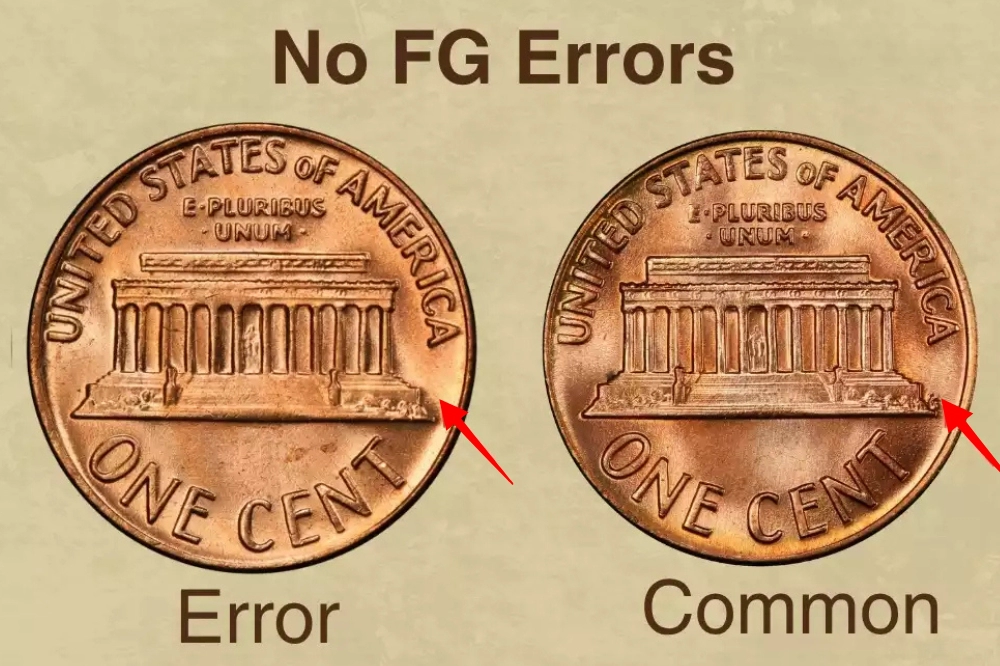
“FG” represents the initials of Frank Gasparro, who designed the Lincoln Memorial reverse, and should appear at the base of the memorial’s right side. When these miniature designer marks disappear entirely, the result is a No FG variety—one of the more accessible errors in the Lincoln Memorial series.
These errors primarily result from overzealous die polishing—when mint employees attempt to remove clash marks or other die damage through buffing, they sometimes accidentally polish away the “FG” initials entirely. In severe cases, this over-abrasion also creates the “floating roof” phenomenon, where memorial columns are partially removed, making the roof appear suspended in mid-air.
Less commonly, No FG errors may occur when grease or debris fills the die’s recessed areas, preventing the initials from transferring onto struck coins.
Among documented examples, the 1969-D is particularly notable and typically valued around forty-five dollars in circulated condition. High-grade uncirculated specimens have reached over five hundred dollars at major auctions.
Known No FG Error Years for Lincoln Cents:
- 1969
- 1969
- 1970
- 1970
- 1971
- 1972
- 1977
33. Clipped Planchet Errors
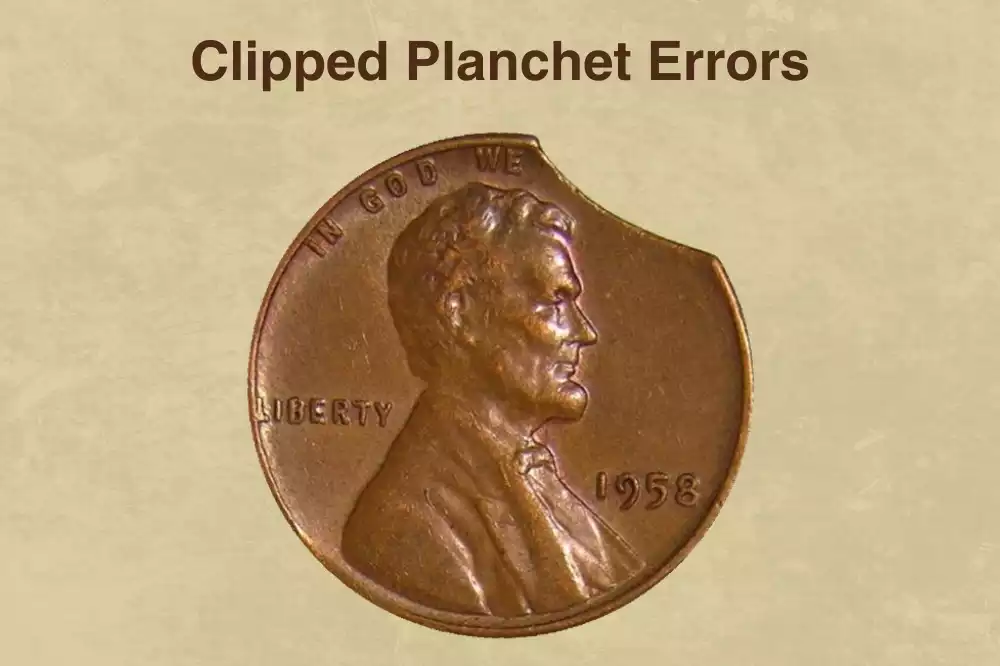
Clipped planchet is one of the most well-known and popular coin errors, classified as a “planchet error” in the PDS (Planchet, Die, Striking) system used by numismatists. These error coins exhibit flat or crescent-shaped bites taken out of the side of a coin, making them easily recognizable to collectors.
The formation of clipped planchet errors occurs during the blank production stage at the U.S. Mint. When the coil stock overlaps during the process of punching metal planchets out of their parent metal, clipped planchet mistakes occur at the U.S. Mint. More specifically, a misfeed can occur when the metal strip is fed through the blanking machine, and the punches sometimes overlap the leading edge of the metal producing a straight clip.
The technical process involves feeding metal strips through blanking machines where circular punches cut out coin blanks. When the strip doesn’t advance properly or overlaps occur, the punches cut into areas where previous blanks were removed, creating the characteristic “clipped” appearance with missing metal sections.
The market value of clipped planchet Wheat Pennies varies significantly based on several factors. The penny values are determined by the clipped percentage and the state of the coin. Generally, values of collectable wheat pennies in good condition can range from several dollars to over $1000, though this applies to various error types and conditions.
Most common clipped planchet Wheat Pennies in average condition typically sell for $10-50, while exceptional examples or those from key dates can reach several hundred dollars.
Known Clipped Planchet Error Years for Penny:
34. Lamination Errors
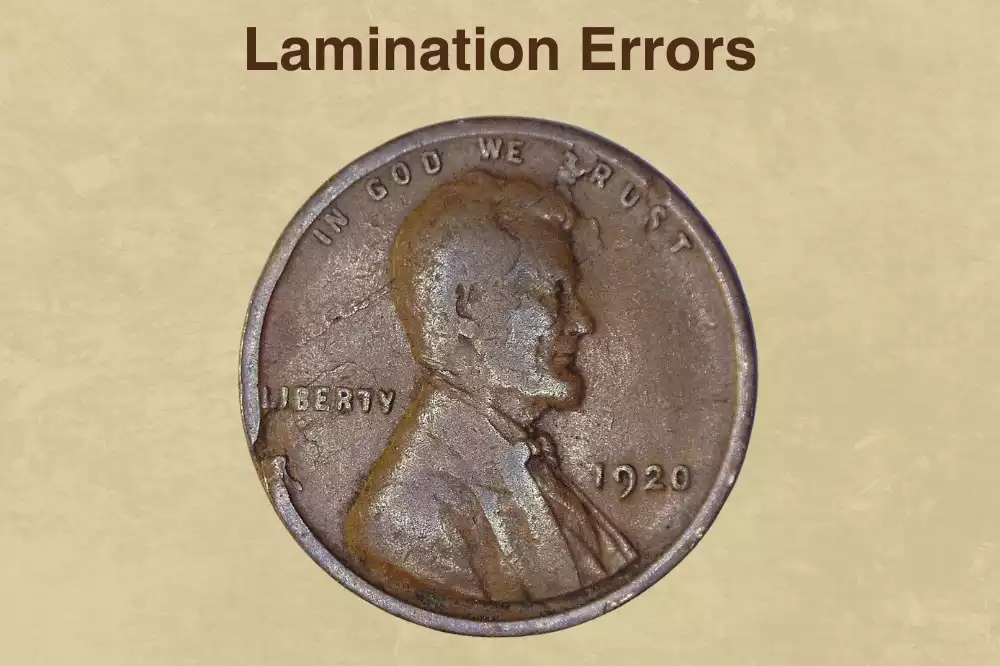
Lamination errors form during the early stages of planchet preparation when foreign materials or impurities become trapped within the metal structure.
During the preparation of the planchet strip, foreign materials like grease, dirt, oil, slag, or gas may become trapped just below the surface of the metal. A lamination is a planchet defect caused when a portion of the planchet metal separates from itself due to impurities or internal stresses.
Metallurgists aren’t quite sure why lamination flaws happen, but most believe that this error results from a planchet’s alloy being contaminated. Over time, coins with lamination flaws begin to peel or crack, with the crack actually being the coin peeling or splitting along its horizontal axis.
If too much grease is applied to the die, it can act like a suction cup, and as the die pulls away after pressing the coin, that added suction can easily remove any loose layers of metal, instantly creating a lamination error coin. These defects can manifest as peeling, flaking, bubbles, or missing metal patches on the coin’s surface.
The market value of lamination error wheat pennies varies considerably based on the severity and location of the defect. Lamination errors on 1945 cents typically sell for $90-160, with larger or more dramatic examples commanding premium prices. A 1919 wheat penny with a lamination crack on the obverse can sell for about $110, but this figure might increase depending on the coin’s condition and the extent of the crack.
Small laminations are fairly common on cents struck during the 1940s and 50s but do not command a high premium, and in some cases cause the value of the coin to be less, while larger laminations and larger denomination coins have higher values.
Known Lamination Error Years for Penny:
35. Weak “D” Errors
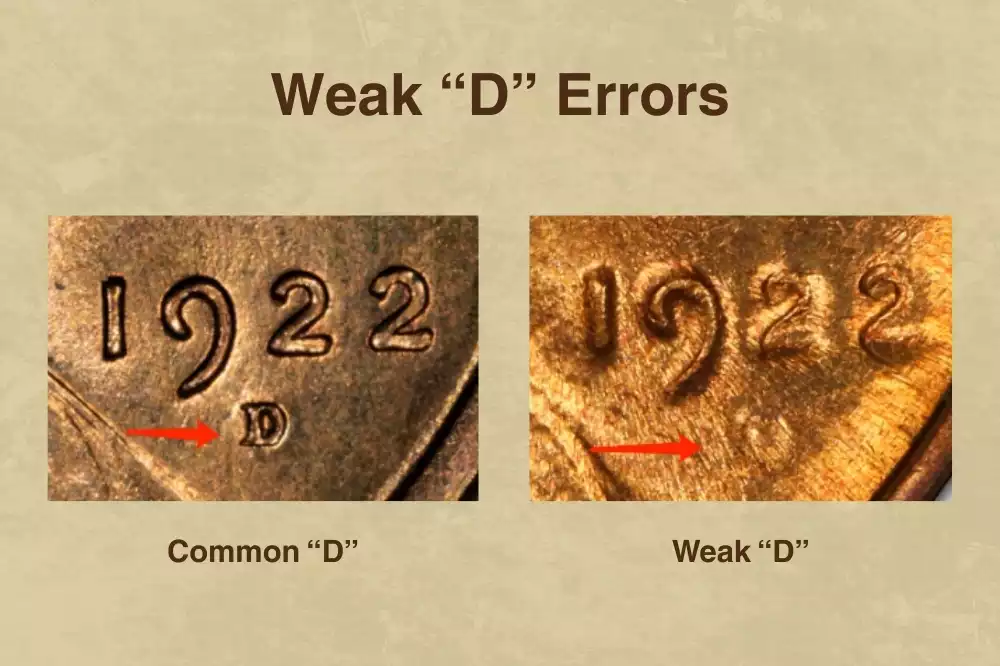
Weak “D” errors form through die deterioration and mechanical wear during the minting process. According to The Official Red Book, in 1922 the Denver mint struck pennies using heavily worn dies, resulting in many Lincoln cents with dull features and a “weak D” mintmark.
Historically, design elements like mintmarks were added by individual iron punches, where technicians positioned a small steel rod with the mirror image and struck it with a hammer to press the image into the die. If the image wasn’t strong enough initially, technicians would punch it a second time, but die wear over time could weaken these punched elements.
Missing or weak design elements can also occur because foreign matter like grease plugs the cavity into which the planchet’s metal would normally flow under striking pressure. The accumulation of debris in die recesses, combined with extensive die usage, gradually diminishes the clarity and strength of mintmarks, producing the characteristic “weak D” appearance where the mintmark is barely visible or partially formed.
A most famous example is the 1922 Weak D Lincoln cent, where heavily worn dies at Denver mint created both weak D varieties and complete “No D” varieties worth over $500 each even in fairly bad condition.
A 1956-D penny with a “shadowy D beneath the normal mintmark” would be worth between $10-$100 depending on condition, while regular 1956-D pennies are worth less than $1 even uncirculated.
Known Weak “D” Error Years for Penny:
36. Missing Mint Mark Errors
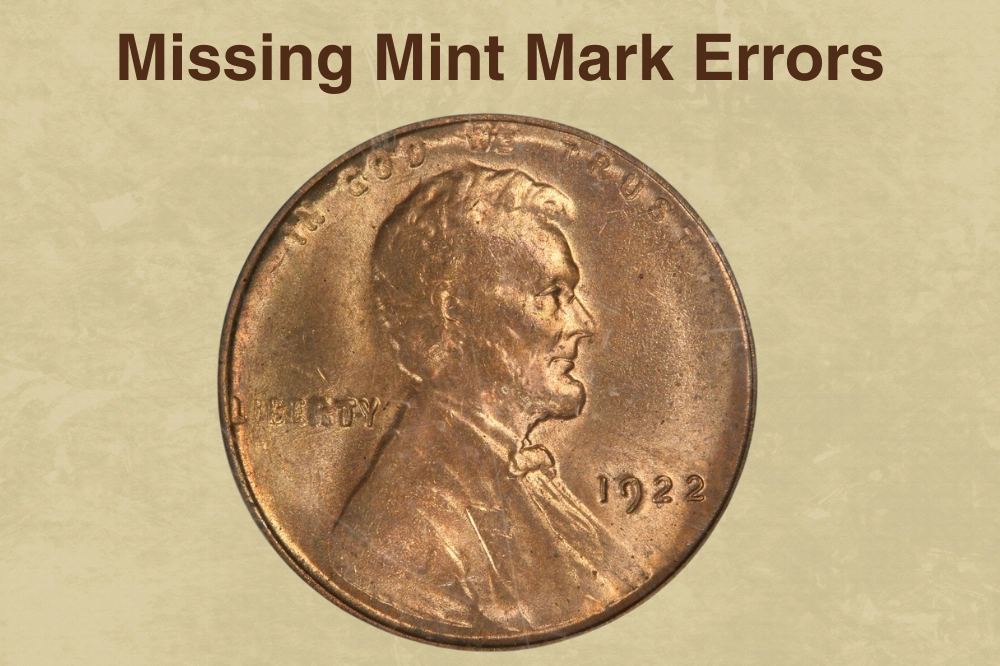
The Missing Mint Mark error occurs when coins are struck without the small letter identifying their production facility. This error displays distinct characteristics, with genuine examples showing uninterrupted flow lines across the surface where the mark should appear, distinguishing them from post-mint damage.
The formation process varies by circumstance. Some errors result from die clashing, where dies strike together without a planchet between them, prompting mint employees to file down the damaged surface and inadvertently removing the mint mark.
Others involve mint grease—a mixture of dirt, metal, and oil—filling the mint mark cavity and preventing proper striking. For proof coins, the error typically occurs when the mint mark is never punched into the die during preparation.
Market values vary dramatically based on rarity. The 1922 No-D Lincoln cent commands $659 to over $19,000 depending on condition. Professional authentication remains essential, as counterfeiters sometimes artificially remove mint marks.
Known Missing Mint Mark Error Years for Penny:
- 1922 No-D
- 1990 No-S
37. Close AM and Wide AM Errors
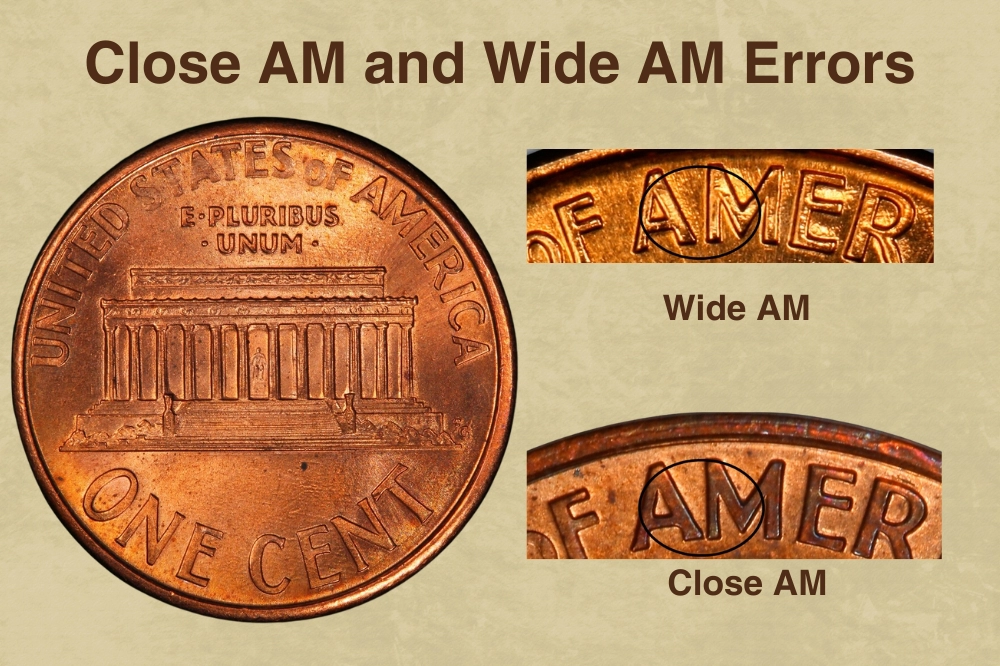
The Close AM and Wide AM varieties emerged from the U.S. Mint’s reverse design evolution for Lincoln Memorial cents. From 1959 through 1992, all pennies featured “Wide AM” spacing where the letters A and M in “AMERICA” stood clearly separated.
In 1993, the Mint introduced a new reverse with “Close AM” spacing where these letters nearly touched at their bases. The Mint then adopted a dual standard in 1994—business strikes carried Close AM while proofs used Wide AM through 2008.
The error occurred when dies intended for different coin types were mistakenly used. The 1992 and 1992-D Close AM cents represent transitional varieties, likely struck as experimental or trial pieces to test the new 1993 reverse design before official production.
Between 1998-2000, business strikes occasionally received proof dies creating Wide AM errors, while some proofs were struck with business strike dies producing Close AM varieties.
The 1992 Philadelphia Close AM stands as extraordinarily rare with fewer than 20 certified examples. A PCGS MS67RD specimen achieved $25,850 in 2017, while even circulated AU55BN examples command $2,500.
The 1992-D variant proves slightly more common with 75 graded specimens, yet MS65RD pieces still fetch $14,100. In contrast, the 1998-2000 Wide AM business strikes, while collectible at $5-50 in lower grades, remain far more accessible with over 100,000 believed to exist.
Close AM errors (should have Wide AM):
- 1992 Close
- 1992-D Close
Wide AM errors (should have Close AM):
- 1998 Wide
- 1999 Wide
- 2000 Wide
Close AM errors (should have Wide AM):
- 1998-S Close
- 1999-S Close
38. 1793 Letter/Word Errors-AMERI Errors

The “AMERI” error refers to the historic 1793 Chain Cent where “AMERICA” was intentionally abbreviated to “AMERI.” on the coin’s reverse due to spacing miscalculation by the engraver. This occurred when the first dies for America’s inaugural cent were hand-cut, and the engraver failed to allow adequate room for the complete inscription “UNITED STATES OF AMERICA,” necessitating the abbreviation to “UNITED STATES OF AMERI.”
This was not a striking error but rather a design error that affected approximately 6,350 coins during the first production run from February 27 to March 12, 1793. These Chain Cent AMERI. varieties are among the most coveted coins in American numismatics, with only an estimated 187 examples surviving across all grades.
Values vary tremendously based on condition – even heavily worn examples in Good condition typically sell for thousands of dollars, while problem-free Fine examples can command thirty thousand to fifty thousand dollars. Verified auction results show dramatic appreciation for higher grades, with an MS61 example selling for one hundred thirty-two thousand dollars in 2020, and an MS66BN specimen achieving two million three hundred fifty thousand dollars in 2015.
The key to identifying genuine AMERI. Chain Cents lies in examining the distinctive chain motif with fifteen links on the reverse and confirming the abbreviated “AMERI.” inscription rather than the full “AMERICA” found on subsequent varieties. Additional authentication markers include the coin’s hefty 13.48-gram weight, 26-27mm diameter, and edge decorated with bars and vines.
39. 1807 Comet Errors
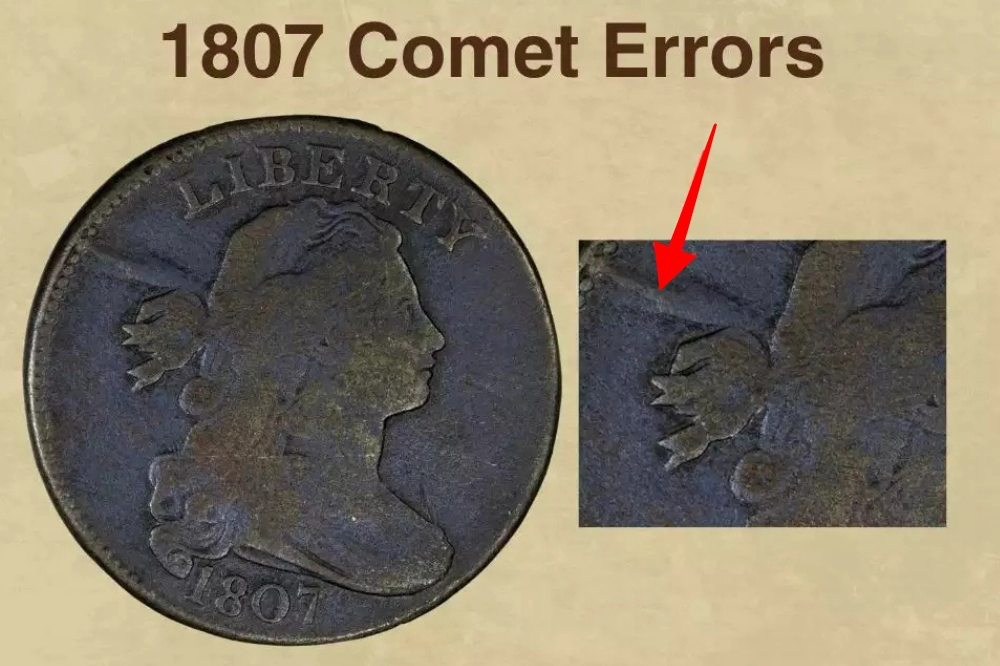
The 1807 Comet variety, designated as Sheldon-271, is a distinctive die variety of the Draped Bust Large Cent characterized by a prominent raised line connecting the rim to Liberty’s hair just above her hairbow.
This defect formed progressively as the die deteriorated through multiple striking stages. Initially, the dies clashed without a planchet between them, creating clash marks on the obverse. Subsequently, the characteristic “comet” flaw developed behind Liberty’s head, becoming increasingly pronounced as the die aged, eventually accompanied by parallel raised marks and a horizontal crack across the bust.
While this is a fairly common variety among 1807 cents, high-grade examples remain scarce, particularly in Mint State condition. Market values range considerably based on condition, with circulated examples typically worth $50-$725, while uncirculated specimens can command $6,000-$38,000. A notable MS-63 Brown example sold for $24,000 at a Stack’s Bowers auction.
Collectors should note that coins displaying a pronounced comet feature carry larger premiums, and early die states without the flaw exist, making die state verification crucial for authentication.
40. 1855 Knob on Ear Errors
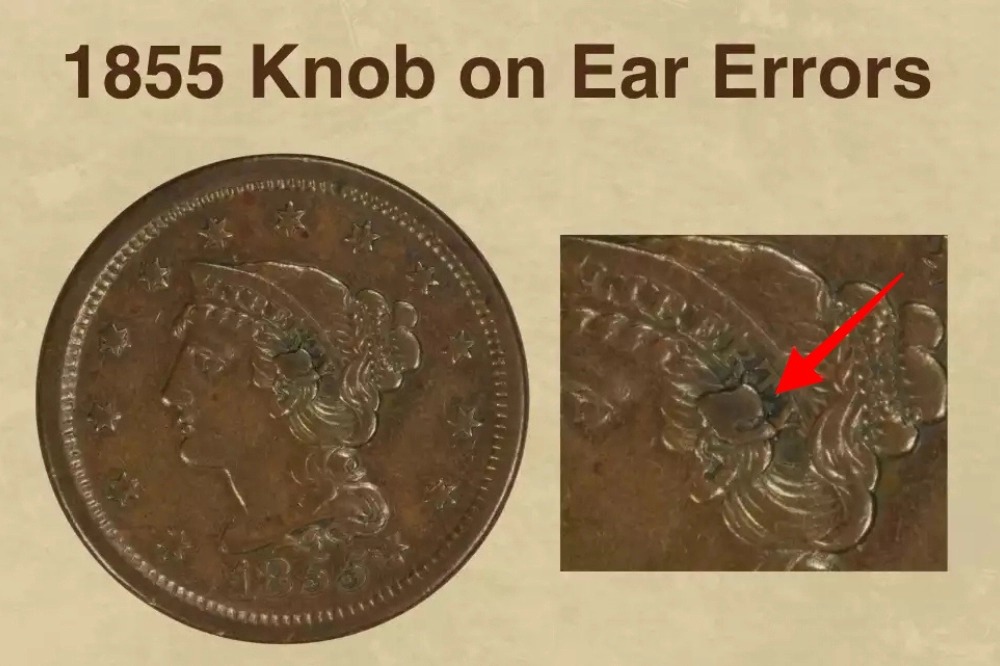
The 1855 Knob on Ear is a distinctive die variety of the Braided Hair Large Cent where a prominent bulge appears on Liberty’s ear. This feature resulted from a small chip that broke out of the obverse die during production, creating a void that filled with metal each time a coin was struck.
The die break actually grew progressively worse as the die continued to be used, creating various die states ranging from subtle to quite dramatic, with some late examples showing what appears almost like a pyramid formation on the ear. The variety only appears on coins with the slanted 5s date style and is designated as Newcomb-9.
In terms of market value, average circulated examples typically sell for around $90, while uncirculated specimens command significantly higher prices ranging from $659 to over $1,100 depending on color designation and condition.
The knob is easily visible to the naked eye, making this a popular and accessible variety for collectors. Higher grade examples with original red-brown or full red color are considerably scarcer and more valuable.
41. 1793 Strawberry Leaf Errors
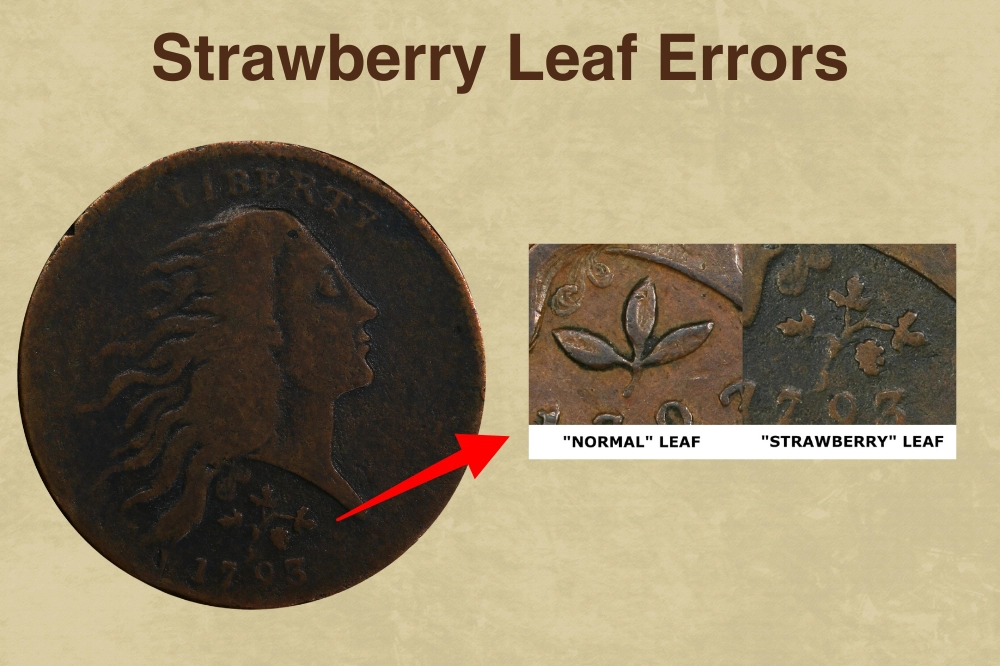
The 1793 Strawberry Leaf cent represents one of numismatics’ most enigmatic varieties. Its defining characteristic appears above the date, where a four-leaf plant cluster replaces the standard three-leaf trefoil sprig. While traditionally called “Strawberry Leaf,” some researchers interpret the design as a cotton plant sprig with a cotton boll.
The variety’s origin remains shrouded in mystery, with no definitive explanation for its creation. Given the experimental nature of 1793 cent production—when three different designs were issued—researchers suggest the Strawberry Leaf may have resulted from artistic license by a mint engraver or represented an early design iteration.
The variation occurred during the die engraving process at the Philadelphia Mint, where the obverse die received this distinctive botanical motif instead of the conventional design.
Only four specimens survive today, making this one of America’s rarest coins. Market values reflect this extreme scarcity, with one example achieving $862,500 at auction in 2009. Another specimen realized $660,000 in 2020.
All known examples show significant circulation wear, confirming they were intended for regular commerce rather than commemorative purposes.
42. Fraction Errors

Fraction errors occur on early U.S. cent varieties where the denomination “1/100” appears on the reverse, representing one cent as one-hundredth of a dollar. The “No Fraction Bar” variety presents a distinctive characteristic where the fractional division bar between “1” over “100” is completely missing from the coin’s reverse, leaving the numerals appearing as “1 100” rather than the intended fraction format.
This error originated during die preparation when the horizontal bar element was inadvertently omitted from the working die before striking commenced. The formation represents a fundamental die creation mistake rather than wear or damage during the minting process. Once discovered, mint officials typically replaced the defective die, but coins already struck with the error had entered circulation, creating a distinct and collectible variety.
The 1794 Liberty Cap Large Cent provides the most notable example of this error. This variety commands approximately $720 in average circulated condition, representing a substantial premium over normal 1794 cents.
The finest known specimen, graded MS-65 Brown by PCGS, achieved $149,500 at Heritage Auctions in February 2008, demonstrating exceptional collector demand. The variety is classified as Sheldon-64 with a Rarity-5- designation, indicating significant scarcity with an estimated 31 to 75 examples surviving across all grades, making it a prized acquisition for early copper specialists.
In Conclusion
The Lincoln penny series demonstrates that mint errors remain an integral part of contemporary coin production despite advanced quality control measures.
From high-value doubled dies and dramatic striking errors to accessible die breaks and planchet anomalies, these varieties offer collecting opportunities across all budget levels.
As minting technology continues evolving, documented error types provide historical snapshots of production methods, making them increasingly valuable to both specialized collectors and numismatic researchers studying American coinage manufacturing processes.
The post 42 Rare Penny Errors List with Pictures (By Year) appeared first on CoinValueChecker.


